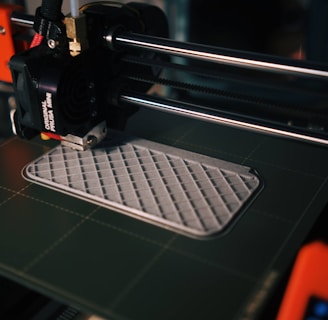3D Printing with Metal Powders
Revolutionizing Modern Manufacturing
by: Abdul Muizz


Metal additive manufacturing, often referred to as metal 3D printing, is no longer just a prototyping tool — it's now a core manufacturing method in sectors like aerospace, medical devices, energy, and defense. By leveraging advanced printing technologies and carefully engineered metal powders, manufacturers can create complex geometries, lightweight structures, and high-performance parts with unprecedented efficiency. This article explores the technologies, materials, powder characteristics, and industrial impact of metal 3D printing.
Metal Additive Manufacturing Technologies
There are several technologies under the umbrella of metal 3D printing, each suited to different applications and design requirements. One of the most established is Powder Bed Fusion (PBF), which includes techniques like Selective Laser Melting (SLM) and Direct Metal Laser Sintering (DMLS). In these methods, a laser fuses layers of metal powder to form a solid object. Each layer is typically between 20 to 100 microns thick, and once it’s complete, a new layer of powder is spread, and the process repeats. This approach enables high precision and excellent material properties, making it popular in critical industries like aerospace and medical implants.
Another process is Electron Beam Melting (EBM), which operates under vacuum conditions and uses an electron beam instead of a laser. It’s particularly suited for reactive metals like titanium alloys and offers advantages in reducing residual stress due to its elevated build temperatures. On the other hand, Binder Jetting takes a fundamentally different approach: instead of melting powder, it deposits a liquid binder onto a powder bed to glue the particles together. The printed object is then sintered in a furnace. Binder Jetting is faster and more scalable than PBF, but the resulting parts typically have lower densities unless additional post-processing is applied. Directed Energy Deposition (DED) is yet another method, where metal powder or wire is melted as it is deposited onto a substrate. DED is especially useful for repairing or adding features to existing components.
Metal Powder Characteristics and Production
The success of any metal 3D printing process hinges on the quality of the metal powder. Unlike bulk metal used in traditional manufacturing, additive powders must meet strict criteria. Particle shape plays a key role — spherical particles are preferred because they flow better and pack more uniformly, which is critical for consistent layer spreading. The particle size distribution also matters; for Powder Bed Fusion, powders typically range between 15 and 45 microns. Powders that are too fine can pose safety risks (e.g., explosivity), while powders that are too coarse may not melt properly.
Purity is equally important. Any contamination—whether from oxygen, nitrogen, or moisture—can introduce porosity, reduce mechanical strength, or even cause cracking in the final part. To ensure consistent performance, high-quality metal powders are usually produced by gas atomization, which results in fine, spherical particles with minimal contamination. More advanced processes like plasma atomization and electrode induction melting gas atomization (EIGA) are used for highly reactive materials like titanium.
Common Materials in Metal 3D Printing
A wide range of metals can be printed today, each suited for specific industrial applications. Titanium alloys, such as Ti6Al4V, are widely used in aerospace and medical fields due to their excellent strength-to-weight ratio and corrosion resistance. Stainless steels like 316L and 17-4 PH are popular for their durability and versatility in general engineering and tooling. Nickel-based superalloys like Inconel 625 and 718 are key materials in aerospace and energy sectors because of their ability to maintain strength at high temperatures.
Aluminum alloys, such as AlSi10Mg, are increasingly used in automotive and aerospace applications for lightweight structural parts. Meanwhile, tool steels (e.g., H13, M300) are essential for high-performance tooling and mold inserts due to their hardness and thermal stability. Cobalt-chrome alloys are often used in dental and orthopedic implants due to their biocompatibility and wear resistance.
Advantages of Metal 3D Printing
The main appeal of metal 3D printing lies in its ability to manufacture parts with geometries that are impossible or cost-prohibitive to produce using traditional methods. Features like internal cooling channels, lattice structures, and organic topologies can be created with ease, unlocking new performance possibilities. It also supports mass customization, enabling engineers to tailor each part to specific applications without the need for retooling.
Another key benefit is material efficiency. Unlike subtractive methods that waste large volumes of raw material, additive manufacturing uses only what’s needed, significantly reducing scrap. This makes it particularly attractive when working with expensive materials like titanium or Inconel. Furthermore, the ability to consolidate assemblies into a single part can reduce labor, weight, and potential failure points.
Challenges and Limitations
Despite its advantages, metal 3D printing is not without its challenges. Equipment and powders are expensive, and the process requires tight control over every parameter—from laser power and scan speed to powder quality and ambient conditions. Post-processing is almost always necessary, including stress relief, heat treatment, machining, and surface finishing. For technologies like Binder Jetting, sintering shrinkage must be carefully accounted for in the design stage.
There are also limitations related to build speed and part size. While metal AM excels at producing complex and high-value parts, it’s not yet economical for large-volume production of simple components. However, with advancements in machine architecture, multi-laser systems, and material handling automation, these barriers are gradually being reduced.
Industrial Applications and the Road Ahead
Industries that demand performance, precision, and lightweight structures are leading adopters of metal 3D printing. In aerospace, components like fuel nozzles, turbine blades, and heat exchangers are now routinely produced using AM. In healthcare, patient-specific implants, surgical tools, and dental restorations benefit from the customization and biocompatibility of printed metal parts. Automotive manufacturers are exploring the use of printed lightweight brackets, structural parts, and motorsport components to push the boundaries of speed and performance.
Looking forward, the integration of machine learning, real-time monitoring, and closed-loop process control is expected to improve quality assurance and reduce defect rates. As powder production becomes more cost-effective and recycling processes improve, metal AM will become increasingly accessible for mid-scale production.
Conclusion
3D printing with metal powders is reshaping the possibilities of design and manufacturing. With the ability to create highly optimized, functional parts from advanced metals, this technology is pushing boundaries in multiple industries. While challenges around cost, process control, and standardization remain, ongoing innovation and investment are steadily overcoming them. For engineers, manufacturers, and forward-looking businesses, metal additive manufacturing is not just the future—it is already transforming the present.
SHAYLIN METAL FZE © 2025. All rights reserved.
